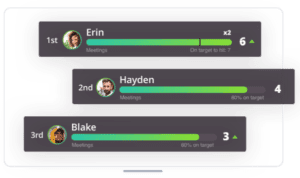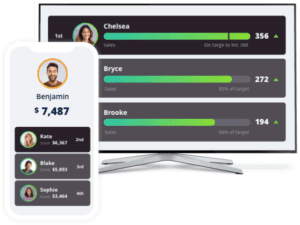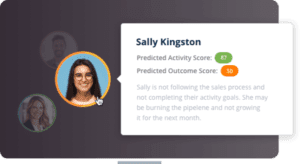If you find yourself managing a sales team for the first time, don’t panic, you just need a great sales dashboard.
Being a first-time sales manager can be challenging, but it’s also a great opportunity to set the right foundations for long-term success. Wisdom may come from experience, but you can get started early.
In this post, we’ll show you what kind of dashboard you’ll need to immediately get results.
Let’s take a look!
What Does a Great Sales Dashboard Look Like?
Your sales dashboard will be your greatest ally as you navigate sales team management for the first time.
There are two functionalities you should expect:
- An insight into the entire sales process
- An insight into your team performance and activities
Your sales dashboard has to help you start from the details (e.g. the number of calls your reps make), and follow that thread to overarching results such as hitting sales targets.
This way, you’ll be able to pinpoint areas for improvement, and recognize your team’s strengths that you can double down on.
You’ll keep your reps engaged and your higher-ups happy.
In order to get there, your sales dashboard has to be…
#1 Your Sales Dashboard Has to Be Simple
One of the most common mistakes we see are sales dashboards that try to monitor and do everything at the same time.
(Even if there is no need to keep track of certain metrics.)
So before you choose a solution, make sure you know the goals and KPIs that matter to you and your sales team.
Include general metrics such as: sales targets, won/lost ratios, and so on.
However, don’t forget about behaviors.
Include metrics that alert you to your team’s performance. These can be emails sent, the number of leads, closes, and so on. The more tangible the metrics are, the better will they motivate your reps.
If you’re managing a big sales team, you might need a complicated dashboard that takes marketing collaboration and business intelligence into account.
However, if you’re a first-time sales team manager and your team isn’t huge, stick with simple dashboards that clearly display everything you need to know.
#2 Your Dashboard Has To Be Engaging
Sales managers may use sales dashboards the most, but that doesn’t mean you can’t take that visual performance tracking to your team.
The truth is, sales reps can easily lose motivation. Surrounded by top performers, it’s easy to feel discouraged.
So as a first-time sales team manager, your mission is to engage your reps.
Fortunately, you can use a sales dashboard like Spinify to do it.
Spinify is a gamified sales dashboard that motivates your team and allows you to unlock their full potential:
- Use leaderboards to encourage healthy competition
- Clearly display everyone’s results on desktop, mobile, and office TVs
- Give points to reps for achieving targets and milestones
- Give out badges to reps
- Allow reps to redeem their points for rewards in Spinify’s reward store
- Assess every rep’s strengths, weaknesses, and areas for improvement
- Coach, motivate, and engage your sales team
In short, Spinify is everything you need to become a great sales manager on your very first day.
#3 Your Sales Dashboard Has To Be Automated
Your sales funnel is not the only thing that can benefit from automation.
In fact, the best sales dashboards for first-time managers are easy and automated. You can set and forget them. They don’t come with complications.
Instead, you simply set up integrations with your CRM and other software, establish the metrics you want to keep track of, and the dashboard will automatically pull data from your tools and display it as leaderboard results on your office TVs.
If you use Spinify, you’ll get your staff hooked on the progress.
After customizing your sales dashboard and leaderboards, they’ll be displayed everywhere.
This way, your team performance will be transparent. Everyone will know exactly where they stand.
And if you incorporate metrics they care about, they won’t just be competing with other reps; they’ll be striving to improve their personal results.
#4 Your Sales Dashboard Has To Be More Than Numbers
While sales is about results, you’ll soon learn that sales – for you – is all about your team.
So if we all understand how crucial individual reps (and their compounded effort) are to meeting targets and improving the company’s bottom line, it’s time to show that in our sales dashboards.
With a dashboard like Spinify, you’ll be able to set individual targets for individual reps.
Maybe Mary wants to increase the number of her calls, since that’s how she contributes most to the sales process. Or maybe she wants to compete with another top performer.
After all, it’s time to hit that target ASAP.
A dashboard like Spinify is flexible. You can accommodate every rep’s unique goals, while keeping track of your team’s goals.
After a while, you’ll also be able to compare your reps’ performance with forecasts.
If they’re lagging behind, you’ll know exactly what you need to coach them on to ensure you hit that target anyway.
#5 Your Sales Dashboard Has To Be Fun
It’s no secret that sales has some of the highest turnover rates.
However, you can stop your team from falling apart with a great sales dashboard.
With a focus on activities and behaviors, Spinify helps hundreds of companies motivate their sales reps and employees every single day. And when your reps feel recognized for the work they do, they’ll be more likely to stay with your company and put in the effort.
Gamification does the trick.
Even simple aspects like redeeming points for rewards and displaying leaderboards that play your reps’ favorite songs when they hit an important target go a long way towards ensuring your team is successful.
Spinify will help you manage a sales team for the first time. But as soon as you try it, you’ll know it’s going to be your partner for a long time.
Keep your reps happy, and improve your results.
Keep updated with Spinify News on our social media profiles: LinkedIn & Twitter






